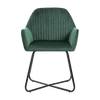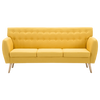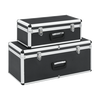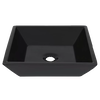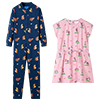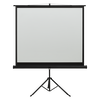How to choose the right desk
A desk isn’t just a desk – it’s a place you spend a significant amount of time working. For this reason, it’s important to pick a desk that will make you feel comfortable and efficient. A well-designed desk will allow you to adjust your posture throughout the day to improve blood flow and relieve psychological strain caused by repetitive work. It will also provide easy access to all the items you need for your daily work.
If you’re facing an empty space or a remodel, you have a big choice to make. Fortunately, when you're wondering where to buy computer desks, there’s a wide range of options to choose from. Whether it’s a simple desk for writing, a large office desk with drawers for storing your office essentials, or a statement-making piece for your business office, there's a desk to suit every space. This guide will walk you through the various stages of choosing the right desk for your workspace.
Discover the different desk types
The first thing to consider when looking for a desk is its purpose. Is it for using a computer monitor, laptop, writing, or organising files? Do you intend to use it for longer hours or occasionally? Your style should also influence your choice of an office desk. Your home office desk should be appealing to the eye and compliment the overall décor scheme of your space. Here are the most common types of desks.
Writing desks
Writing desks feature a flat, basic surface for writing and typing. They have a simple and streamlined design, making them versatile desk styles that can easily slot into virtually any space. Writing desks come in a wide range of styles, ranging from traditional to modern. Most writing desks have small shelves or drawers underneath the writing surface. They also have slender legs as they don’t have a lot of storage space.
Computer desks
Computer desks have everything a classic computer user needs for a functional workspace. Their designs allow you to keep your computer monitor, laptop, and printer within arm’s reach. They also come with shelves for storing the keyboard and other accessories like external hard drives. Some computer desks have a hutch to utilise the space above the computer. These computer desks for home and office are usually large and are ideal for serious computer users.
Executive desks
Large and often close to the ground, executive desks feature a flat, sleek top and unbeatable storage in the form of drawers. Most of them come with spaces for storing sensitive documents and equipment. You can distinguish executive desks by their wide top, which provide ample space for writing, typing, and storing baskets and inboxes for paperwork. These large desks are more common in commercial offices, although they can also suit any home office. They make a great statement piece, especially for those who want to create an office or study area at home. They are also a good option for professionals who want to impress their clients.
Corner desks
Corners desks help you make the most of your space. As the name suggests, these desks fit nicely into a corner. When paired with the right desk chairs, they make great computer desks for people who want to maximise space. You can place your computer monitor in the middle and other work essentials on either side of the computer table. Corner desks can make an excellent gaming desk or home office desk.
Standing desks
These desks allow you to work comfortably while standing.They promote good posture and boost blood circulation, which in turn boost your energy levels and mood. In addition, they improve wrist positioning. You can also use it as a temporary writing desk.
What is the best material for office desks?
The construction of an office desk for home or business has an influence on its appearance and durability. Desks come in different materials to suit your tastes and preferences. But how do you know which material is best for you? Let’s discuss the different types of materials you can choose for your desk.
Wood
Desks made of wood bring in timeless quality that no other material can replicate. The strength and durability of wood makes it one of the most preferred for desks. Wood desks have an attractive, natural look that adds warmth and a sense of dignity to your workstation. In addition, they come in a wide range of textures, grains, and finishes that match any décor theme. Genuine wood is more durable but requires proper care to keep it in top condition.
MDF
MDF (medium-density fiberboard) is a common material for desks. Made out of wood-mill byproducts, MDF is a great alternative to solid wood. Desks made of MDF have a smooth, consistent finish, even for pieces not covered in a finished decorative material. They also offer superior strength, which creates a no-sag surface for the desktop and shelves. MDF in its unfinished form is susceptible to water damage, but when covered with veneer or laminate, they become resistant to water.
Metal
Strong and resilient, metal is neither a cheap or expensive alternative to wood. Desks made of metal won’t dent or scratch easily, so you can confidently use them in high-traffic spaces. Metal is the best material for industrial and modern desks. Most metal desks are either powder coated or painted to prevent rust. An occasional wipe down with a wet cloth should keep your home desk in good condition for a few years. To reduce weight, most metal desks for home and office have an open-frame design, which also makes them a great fit for small rooms.
Glass
Glass desks are a classy and stylish option that works well in modern offices. They have a clear surface that eliminates obstruction, making the room look bigger and cleaner. Most glass desks have metal bases for support. They also feature tempered glass, a type of safety glass hardened for strength and resistance to scratches.
How to choose the right desk size
Choosing a comfortable desk size that provides enough space is vital in encouraging productivity. Before selecting a desktop size, make sure that you measure your space. You also need to consider your needs and preferences, such as the shape of the desk.
Desk measurements, which include length, height, and width, help you select a desk size that suits your needs. Let’s look at a few desk sizes to give you a rough idea of what could work in your space.
- Width: The width or length of a desk is the measurement from left to right as it looks when using it. The minimum length of a desk is at least 20 inches, which is sufficient to hold a monitor. However, the standard measurements are 48, 60, and 7 inches.
- Depth: This refers to the measurement from the front to the back as you sit. A standard desk has a depth of 24 to 36 inches. The right depth for your desk depends on the space you need for your laptop or any equipment you have.
- Height: The height of a desk is the measurement from the base to the top. The standard height of a desk is 30 inches. Choosing a desk with the correct height ensures that you sit comfortably without feeling cramped.
Which desk style suits your office space?
In the constantly changing world of office furniture, knowing which desk offers the perfect blend of practicality and style is challenging. Gone are the days when people had to settle for any office desks and storage units they found on the market. Today, setting up a workplace that reflects your brand or style is just as important as the business itself. Your workspace design influences the type of desk you need.
Farmhouse
For a traditional office design, go for a comfortable wood desk. It will add a touch of class and tradition to your workspace setup. Wood desks also work well with your wood grain or white office furniture.
Contemporary
Adding modern furniture to a contemporary workplace immediately improves its appearance. Having a contemporary office space can give the impression that you’re constantly innovating and are not afraid to stay up to date on trends. Office and home desks that work well with modern spaces often have a sleek and stylish appearance with gentle curves and round edges or sides. They can be made out of metal, wood, and other materials.
Industrial
An industrial-style office desk often features a metal structure. Metal desks offer exceptional strength and durability. They make great choices for people who want to use two or more computer monitors or have large gaming setups.
Tips for office desk care
Regardless of the type, size, or style of office desk you choose, you need to take care of it to ensure it remains in good condition for years. Keeping your office space neat and tidy will not only help you to work more efficiently, but also give you peace of mind. Here are a few care tips to keep your desk table in top condition.
- Have a cleaning routine: The first step to ensuring you have a tidy computer desk is having a cleaning routine. You can set the alarm at a certain time to remind you that you need to organize your files or take the garbage out.
- Dust daily: The best way to get rid of dust is to ensure it doesn’t build up. Use a cloth or paper towel to remove dust every day when you arrive in the morning or before you leave in the evening.
- Organize your essentials: Make sure you organize your items so they are within reach. All your essentials should be within reach to help you save time in the long run.
- Protect wood desks: Wipe away any spillage as soon as possible. Ensuring a consistent level of humidity on your large office desk prevents the wood from warping.
Want to create a comfortable workspace? Check out of fantastic range of desks.
Looking for other products? Check out the categories below:
Type: Corner Desk - Computer Desk - Small Computer Desk - Computer desk with shelves - Computer desk with keyboard tray - Concrete look desk - Small desk - Narrow desk - Long desk
Color: White Desk With Drawers - Black desk with drawers - High gloss white desk
Interior Design Style: Vintage Desk - Rustic desk - Antique desk
Material: Mango wood desk - Oak desk - Teak desk - Metal desk

